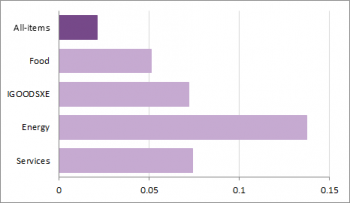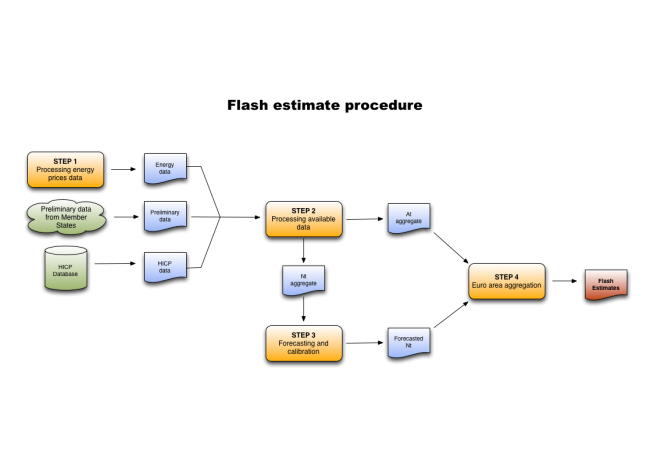Archive:Inflation – methodology of the euro area flash estimate
- Data from February 2012-February 2013, most recent data: Further Eurostat information, Main tables and Database.
Changes in the price of consumer goods and services are usually referred to as the inflation rate. Inflation represents the loss of living standard over time and is one of the most well-known economic statistics. This article analyses the accuracy of the euro area inflation flash estimates, usually released at the end of the reference month and describes the methodology used in their production.
Accuracy of the flash estimates
The aim of the inflation flash estimates is to predict as accurately as possible the actual inflation rate released later. Since accuracy is the degree of closeness of measurement of a quantity to that quantity's actual (true) value, the flash estimate is considered to be accurate if its value, rounded to one decimal place, is the same as the HICP annual rate, rounded to one decimal, published two weeks later. Table 1 compares the flash estimates and the HICP annual rates for the same reference month. Over the last 12 months, the maximum difference between the flash estimate and the HICP annual rate was 0.4 (recorded in September 2012 for the non-energy industrial goods component).
The mean absolute deviation provides another way to measure accuracy. It is the average of the absolute differences between the flash estimate and the HICP annual rate over time. Figure 1 shows the mean absolute deviation over the last 12 months for the all-items figure and the four main components.
The energy component has recorded the highest mean absolute deviation (around two times the services mean absolute deviation) over the last 12 months.
A third way to evaluate the flash estimates' accuracy is to look at how they predict the direction of inflation. The flash estimate correctly predicts the direction of inflation if the difference between the flash estimate and the previous month inflation has the same sign as the difference between the actual inflation and the previous month inflation. For example, if the flash estimate is pointing to an increase on inflation and that increased is confirmed two weeks later, then the direction of inflation was accurately predicted.
There are three possible outcomes for the direction comparison:
- The flash estimate correctly predicts the direction of inflation if the predicted increase / decrease / no change in inflation is confirmed (denoted by
 );
);
- The flash estimate wrongly predicts the direction of inflation, e.g., it predicts an increase when there is a decrease (denoted by
 );
);
- The flash estimate points to an increase / decrease but the final figure remans unchanged; or the flash estimate predicts no change in inflation but the final figure points to an increase / decreaseit (denoted by
 ).
).
Over the last 12 months the flash estimate accurately predicted the inflation's direction in 48 out of 60 estimates, and in only 2 out of 60 estimates the direction was wrongly predicted.
Note: the first flash estimate breakdown into four main components was published in September 2012. Prior to that, flash estimate figures for food, non-energy industrial goods, energy and services were computed to test the accuracy of the algorithm in predicting their respective inflation rates, but only the all-items estimate was published at the end of each reference month.
Computation of flash estimates
The flash estimate procedure combines early HICP information from the euro area countries with a one-step ahead forecast for countries that were not able to provide preliminary information. Forecasts are based on statistical models which use timely energy price data from the Weekly Oil Bulletin, HICP back series and the preliminary data for the available countries. The model estimates national HICPs and their main components (if not provided by a Member State) and aggregates them to the euro area level, together with the available flash estimates provided by the countries, to produce the flash estimates for the reference month.
There are five main steps that take place sequentially:
- Defining model specifications;
- Processing energy prices data;
- Processing available data;
- Nowcast;
- Calibration.
STEP 1: Defining model specifications
In this step, the model specifications are checked in order to find out if there is a model that performs better than the one used in the last round of flash estimates production. If a better model is found, it is used in Step 4.
STEP 2: Processing energy prices data
For improving the forecasting power of the model, the HICP data are combined with timely price data on fuels and heat energy. The information is received from DG ENER's Weekly Oil Bulletin; they publish prices of diesel, petrol and heat energy in their Weekly Oil Bulletin. At the time of the flash release, the energy price data of the last week of the month are normally missing; an automatic forecast for the missing week is made for each euro area country, and the monthly averages are calculated from these weekly price data are used in the nowcast.
STEP 3: Processing available data
In this step, countries are separated into two groups: group 'A' countries which have provided preliminary data for the current month and group 'N' countries which have not. For each group, the available data for HICP and energy prices are aggregated into a single index; i.e., for the all-items aggregate, one index is created for group 'A' and one for group 'N'; for 'food', one index is created for group 'A' and another for group 'N', and so on. The HICP index for group 'A' has an extra observation (i.e. the preliminary data for the month in question) compared to the index series for group 'N'.
STEP 4: Nowcast
This is the main step of the flash estimate procedure in which the 1-step ahead forecast and aggregation are done. For each of the euro area sub-component indices, an aggregate of countries 'N', i.e. without preliminary data, is forecasted using the model specified in Step 1 and the energy prices data and / or available preliminary data provided by other countries processed in Step 2. These one-step ahead forecast indices are aggregated with the aggregate of 'A' countries preliminary data, producing the (non-calibrated) nowcast for each sub-component of the flash estimate.
STEP 5: Calibration
The four sub-components 'food', 'non-energy industrial goods', 'energy' and 'services' have to aggregate correctly to the 'all-items' index. Since the nowcasts are calculated independently for each individual special aggregate, it is almost certain that their aggregation is not equal to the all-items nowcast. In Step 5, the 'un-balanced' component nowcasts are calibrated to fulfill the consistency requirement.
Models used
Prior to any model fitting, the first differences of the logs are taken:
 where
where is the aggregated index of the set of countries that have not provided any preliminary data. This will be the dependent variable to be forecasted;
is the aggregated index of the set of countries that have not provided any preliminary data. This will be the dependent variable to be forecasted;
 where
where  is the weighted average of 'diesel' prices of the set of countries that have not provided preliminary data;
is the weighted average of 'diesel' prices of the set of countries that have not provided preliminary data;
 where
where  is the weighted average of 'petrol' prices of the set of countries that have not provided preliminary data;
is the weighted average of 'petrol' prices of the set of countries that have not provided preliminary data;
 where
where  is the weighted average of 'heat' prices of the set of countries that have not provided preliminary data.
is the weighted average of 'heat' prices of the set of countries that have not provided preliminary data.
For each aggregate that needs to be forecasted there are four possible regressors. Depending on the special aggregate, some regressors might not be significantly correlated with the dependent variable, so they are not likely to be used in the forecasting model.
Nowcasting the all-items aggregate
The model used to fit the 'all-items' is a regression model with SARIMA errors, given by:
The parameters for the SARIMA were previously determined in Step 1 of the flash estimate procedure and they are described in the model specifications file.
where ![]() is a forecast from the SARIMA model shown above. The final step is to produce the nowcast index for the all-items, by aggregating
is a forecast from the SARIMA model shown above. The final step is to produce the nowcast index for the all-items, by aggregating ![]() with
with ![]() .
.
Nowcasting the main components
Although the main components to be published are four, i.e., 'food' (FOOD), 'non-energy industrial goods' (IGOODSXE), 'energy' (ENRGY) and 'services' (SERV), in the estimation ENERGY is split into ELGAS, the result of the aggregation of electricity, gas, solid fuels and heat energy, and FUELS, the result of the aggregation of liquid fuels and fuels and lubricants for personal transport equipment. The split of ENRGY into ELGAS and FUELS results in improved final accuracy. Since the two sub-components have significantly different dynamics, the indirect forecast (forecasting the sub-components first and then aggregating the forecasts) on average performs better than the direct forecast (forecasting 'energy' directly).
Calibrating the main components
As final step in the estimation procedure, the main components nowcast are calibrated so that their aggregation equals the nowcast for the all-items, making the five nowcast consistent. The calibration factor is given by:
Finally, the calibrated nowcasts for the main components are given by multiplying each nowcast by ![]() .
.
Further Eurostat information
Database
- Harmonised indices of consumer prices (HICP) (prc_hicp), see a predefined selection under these links:
- HICP (2005 = 100) - monthly data (annual rate of change) (prc_hicp_manr)
- HICP (2005 = 100) - monthly data (index) (prc_hicp_midx)
- HICP (2005 = 100) - monthly data (monthly rate of change) (prc_hicp_mmor)
Dedicated section
Methodology / Metadata
External links
- European Central Bank - Survey of Professional Forecasters
- European Commission - Directorate-General for Economy and Finance - Economic Forecasts



